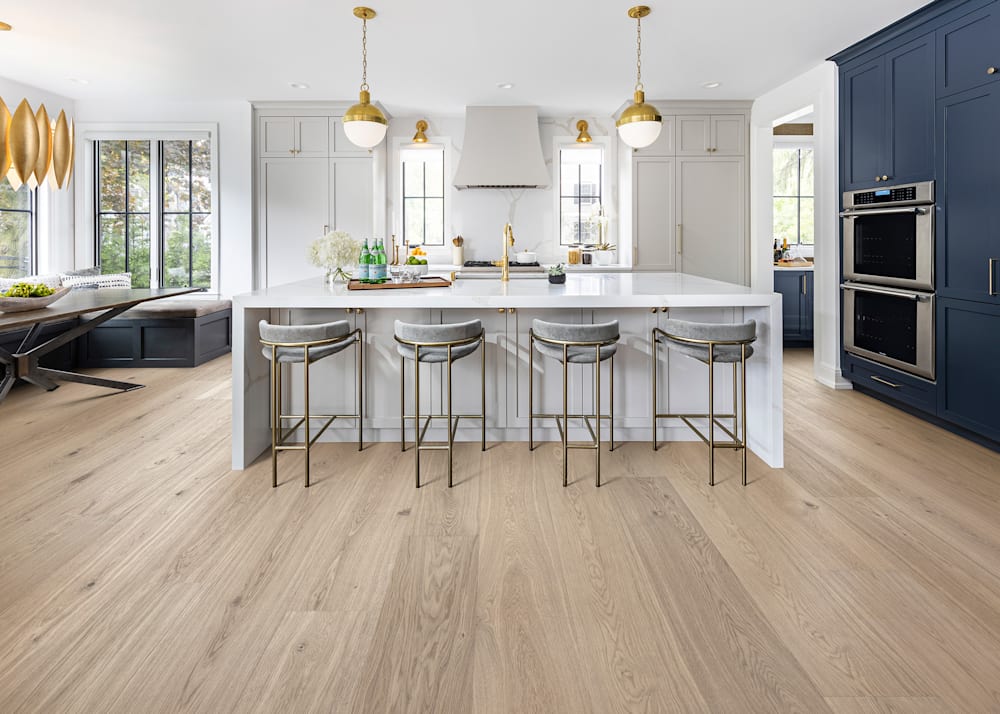White Oak Flooring: The Complete Guide to Oak Flooring

Introduction:
White
oak flooring is celebrated for its timeless elegance, durability, and
versatility in interior design. As a popular choice among homeowners and
designers alike, white oak offers a combination of natural beauty, strength,
and aesthetic flexibility. This comprehensive guide explores everything you
need to know about white oak flooring, from its characteristics and benefits to
installation methods, maintenance tips, and design considerations.
Characteristics and Benefits
Durability:
White oak is renowned for its hardness and durability, making it suitable for
high-traffic areas in residential and commercial spaces. It resists wear,
dents, and scratches better than many other hardwood species.
Color and Grain:
White oak features a natural light to medium brown color with subtle
variations in grain patterns, including straight grains and occasional swirls.
Its neutral tone complements a wide range of interior styles.
Versatility:
Suitable for both traditional and modern interiors, white oak flooring blends
seamlessly with various design themes and color schemes. It can be stained or
finished to achieve different looks, from rustic to contemporary.
Dimensional Stability:
White oak has excellent dimensional stability, meaning it is less
prone to shrinking and expanding due to changes in humidity and temperature
compared to other hardwoods.
Ease of Maintenance:
With proper care, white oak flooring can maintain its beauty
and integrity for decades. Regular sweeping, vacuuming, and occasional mopping
are typically all that's needed to keep it looking pristine.

Types of White Oak Flooring
White
oak flooring is available in different types based on construction and
installation methods:
Solid White Oak:
Made from solid planks of white oak wood, this type of flooring can
be sanded and refinished multiple times over its lifespan. It offers durability
and a classic hardwood appearance.
Engineered White Oak:
Engineered flooring consists of a thin layer of white oak veneer
bonded to layers of plywood or fiberboard. This construction enhances stability
and is suitable for installation in basements or over concrete slabs.
Finished vs. Unfinished:
White oak flooring comes in both finished and unfinished
options. Finished flooring has a protective topcoat applied at the factory,
while unfinished flooring requires on-site sanding, staining, and finishing.
Installation Methods
Depending
on the type of white oak flooring chosen, installation methods may include:
Nail-Down Installation:
Solid white oak planks are typically installed by nailing them
directly to a wooden subfloor using a flooring nailer. This method provides a
secure and stable floor.
Glue-Down Installation:
Engineered white oak flooring can be glued directly to a concrete
subfloor using recommended adhesives. It creates a strong bond and is suitable
for environments where moisture resistance is necessary.
Floating Installation:
Engineered white oak planks can be installed as a floating floor
over an underlayment without nails or glue. Planks interlock with
tongue-and-groove joints, allowing for flexibility and ease of installation.
Maintenance and Care Tips
To
preserve the beauty and longevity of white oak flooring, follow these
maintenance and care guidelines:
Regular
Cleaning: Sweep or vacuum the floor regularly to remove dirt, dust, and debris.
Use a hardwood floor cleaner recommended by the manufacturer to maintain the
finish.
Avoid
Water Damage: Wipe up spills immediately using a dry or slightly damp cloth.
Excess moisture can damage the wood and finish over time.
Protective
Measures: Use felt pads under furniture legs to prevent scratches and dents.
Place rugs or mats in high-traffic areas and entryways to trap dirt and
moisture.
Periodic
Maintenance: Inspect the floors periodically for signs of wear or damage.
Consider refinishing or recoating the floors as needed to restore their shine
and protection.
Design Considerations
When
incorporating white oak flooring into your interior design, consider the
following factors:
Interior Style:
White oak's neutral tone and versatile grain pattern complement various
interior styles, including traditional, rustic, modern, and Scandinavian. It
can be stained to achieve darker or lighter shades to match your decor.
Room Size and Lighting:
Lighter shades of white oak can make small rooms appear more
spacious and airy, while darker shades add warmth and coziness to larger
spaces. Consider natural and artificial lighting to enhance the natural beauty
of the wood.
Furniture and Accessories:
Coordinate furniture and decor elements to complement the
natural beauty of white oak flooring. Light-colored furniture and minimalist accessories
can create a modern and elegant look, while rustic or vintage pieces can
enhance a traditional or farmhouse aesthetic.
Conclusion:
White oak flooring offers a timeless elegance, durability, and versatility that make it a popular choice for homeowners seeking to enhance their living spaces. Whether you prefer the classic appeal of solid white oak or the enhanced stability of engineered white oak, there are options to suit every style and budget. By understanding the characteristics, benefits, types, installation methods, maintenance tips, and design considerations of white oak flooring, you can make an informed decision that transforms your home with natural beauty and enduring quality. Enjoy the warmth, durability, and timeless charm of white oak flooring for years to come.









